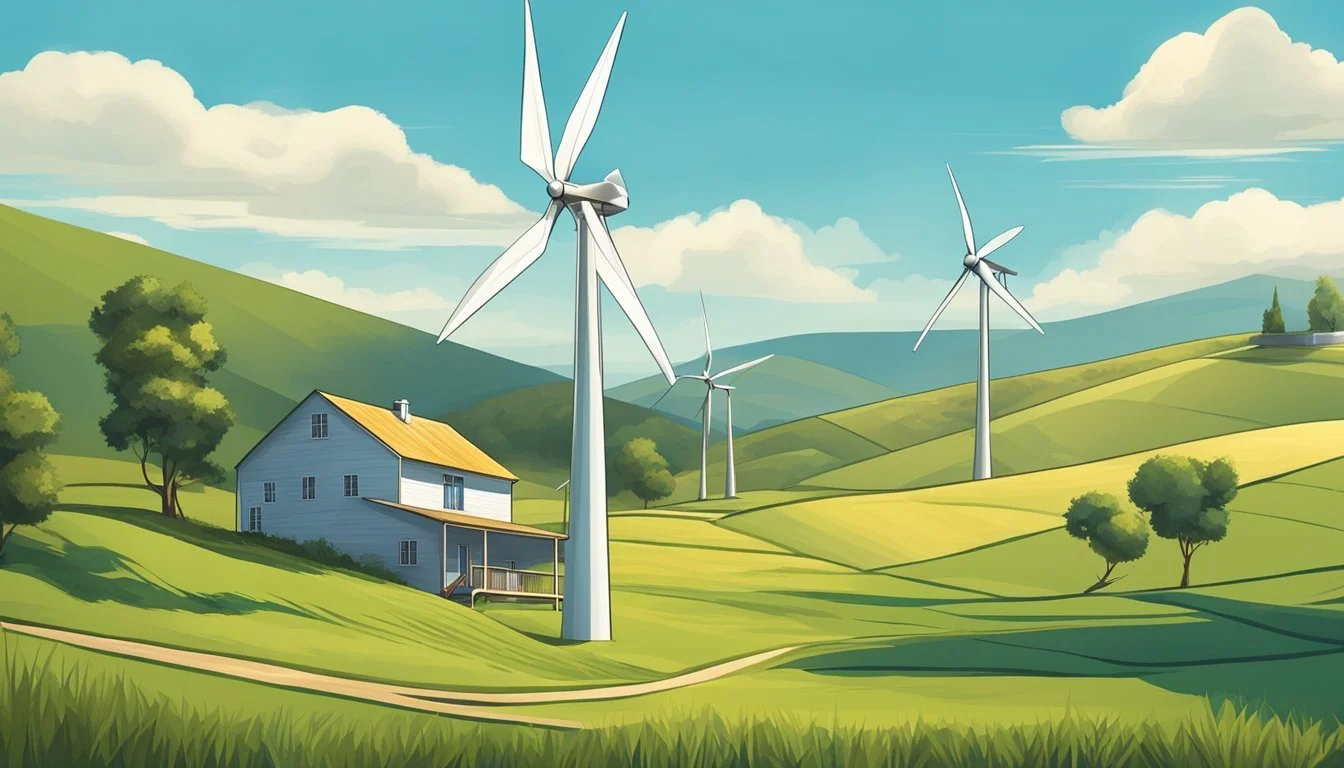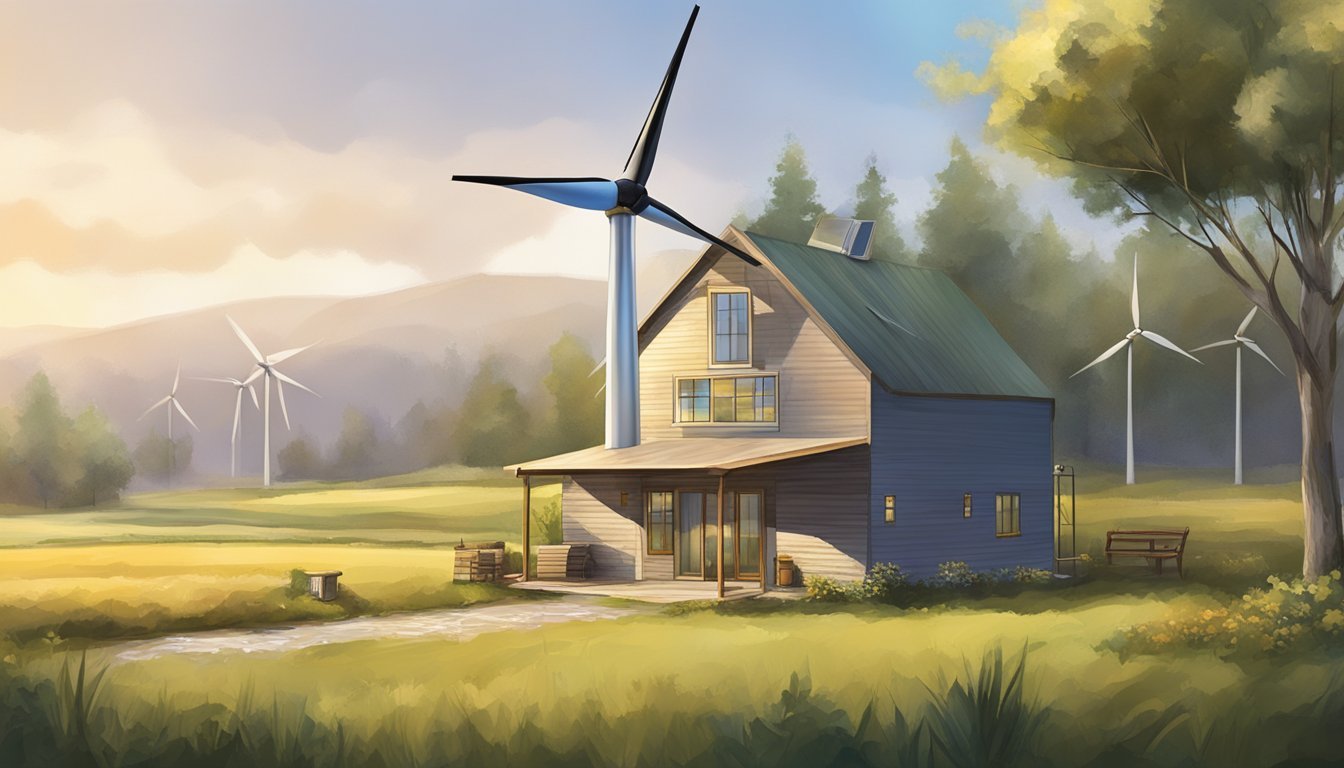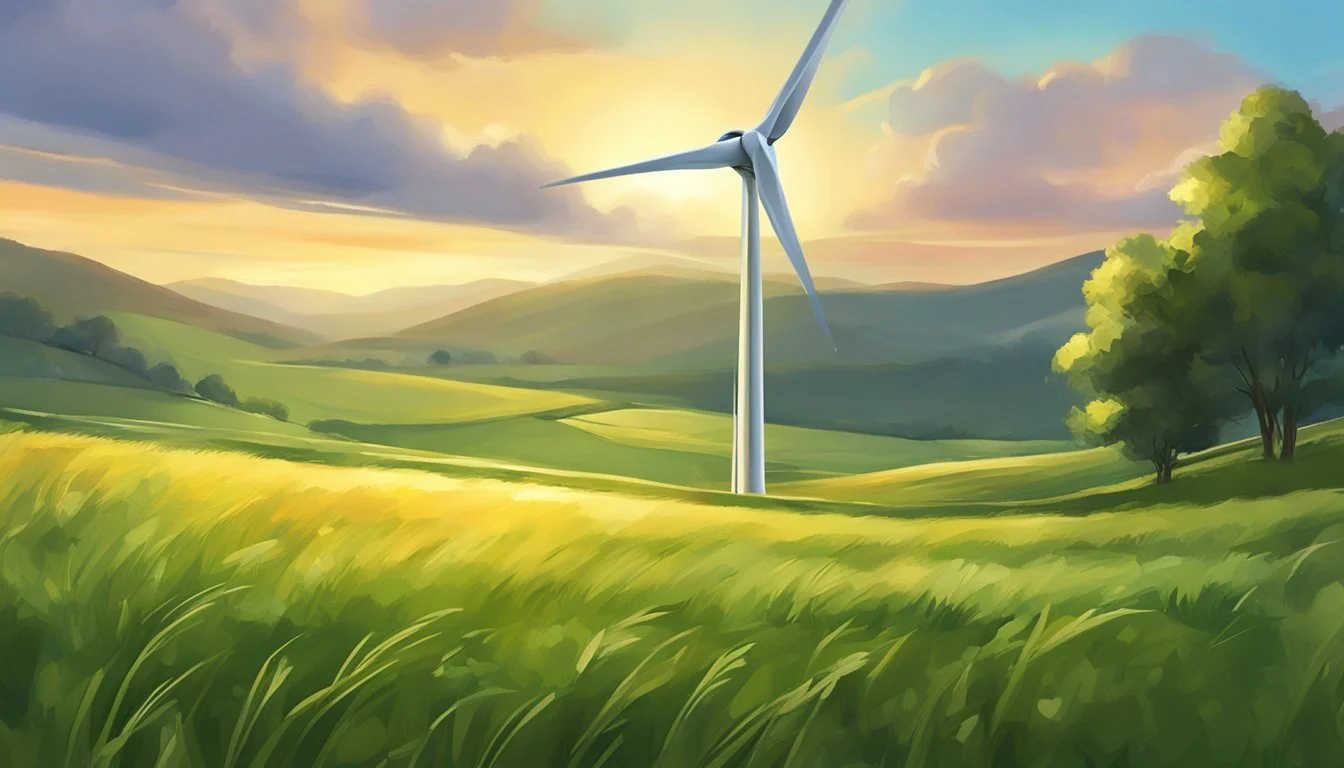Power Your Homestead with a Portable Wind Turbine
Achieving Sustainable Energy Independence
Harnessing wind as a source of energy is an innovative and sustainable approach to powering a homestead. Portable wind turbines offer a unique solution that can generate electricity for a variety of household needs. These turbines convert the kinetic energy from the wind into electrical energy, presenting a viable option for those seeking to reduce dependence on traditional power grids and lower their environmental impact.
The effectiveness of wind turbines for residential use varies based on location, wind speeds, and the size of the turbine. Small-scale turbines, which can range from models just powerful enough to charge a battery to those capable of powering multiple homes, have become more accessible with advancements in technology. This technology is complemented by incentives such as tax credits, which serve to encourage the adoption of renewable energy sources.
As the global installed capacity of wind energy continues to rise, the use of wind turbines, specifically portables, plays an increasingly significant role in the shift toward sustainable living. With careful consideration and planning, homeowners can potentially offset a portion of their energy consumption, contributing to a greener future while also possibly reducing their electric bills. Portable wind turbines are not only a testament to human innovation but also a practical step towards energy independence for environmentally conscious homesteaders.
Understanding Wind Energy
In harnessing the power of wind, individuals contribute to sustainable energy efforts while tapping a clean resource. Wind power represents a key facet in the green energy revolution.
Basics of Wind Power
Wind energy utilizes the natural movement of air to generate electricity. A wind turbine converts kinetic energy from the wind into mechanical power. This mechanical power can either be used for specific tasks, like pumping water, or converted into electricity.
Key Components: Most turbines comprise a rotor with blades, a shaft, and a generator.
Sizes: They can range from small units of 1-kilowatt capacity to large 100-kilowatt systems.
Suitability: Wind turbines are site-specific; optimal operation requires average wind speeds of at least 12 to 14 miles per hour.
Advantages of Wind Energy
Wind energy is a standout in sustainable power generation due to several key advantages:
Eco-Friendly: Produces no pollutants, thereby reducing greenhouse gas emissions.
Renewable: Wind is plentiful and inexhaustible.
Cost-Effective: After initial investment, the operational costs are low.
Wind vs Solar Energy
When deciding between wind and solar energy, it's important to consider the following points:
Wind Energy:
Better suited for areas with high wind speeds.
Turbines can generate power day and night, as long as there is wind.
Solar Energy:
Ideal for regions with abundant sunshine.
Panels generate power only during daylight hours, requiring storage solutions for nighttime use.
Each system has its own requirements and benefits, and they can often be complementary when used in a hybrid system.
The Science Behind Wind Turbines
Wind turbines harness the motion of wind and convert it into electricity through precision engineering and the principles of aerodynamics.
Aerodynamics of Turbine Blades
Turbine blades are shaped to capture the kinetic energy of the wind. The design of the blades allows them to act akin to airplane wings. As wind passes over the blade’s surface, lift and drag forces are generated. The lift force is higher on the front side of the blade due to the shape and orientation, which causes the blade to rotate. The blades are strategically pitched to maximize efficiency, and the engineering goal is to generate the maximum rotational speed from the available wind energy.
Electricity Generation Process
Once the blades are in motion, they turn a rotor connected to a generator. Here's a simplified breakdown of the process:
Rotation: The wind's kinetic energy causes the turbine blades to spin.
Transmission: The rotational energy from the blades is transferred to a rotor.
Generation: The rotor, which is connected to a generator inside the turbine, converts the mechanical energy into electrical energy.
Transformation: Electrical transformers then adjust the voltage for compatibility with the power grid or for direct use.
The science and engineering of wind turbines involve an intricate balance of maximizing energy capture and efficient conversion to electricity, which makes portable turbines both a practical and sustainable option for homestead energy production.
Portable Wind Turbines
Portable wind turbines are revolutionizing sustainable energy generation for homesteads by offering versatility in energy production in various environments.
Benefits and Features of Portable Models
Portable wind turbines bring the advantage of flexibility and convenience to sustainable energy. They afford users the capacity to generate power in remote locations, rendering them ideal for outdoor enthusiasts or those living off the grid. Key attributes of portable models include:
Ease of transport: Their lightweight design allows for easy relocation.
Quick setup: Many models are designed for simple and rapid assembly.
Variable power output: Depending on the size, portable turbines can range in power generation, suitable for charging small devices or supplementing home energy needs.
Shine Turbine by Aurea Technologies
The Shine Turbine, developed by Aurea Technologies, is a notable example of portable wind technology. Weighing just three pounds, it is touted for its efficiency and compact size. Details about the Shine Turbine:
Weight: Less than 1.4 kilograms.
Power-to-weight ratio: 29.5 watts per kilogram.
Charging capabilities: Capable of charging a phone in approximately 20 minutes.
Setting Up Your Portable Wind Turbine
Setting up a portable wind turbine like the Shine is generally a straightforward process designed for consumer ease:
Select an optimal location: Find an open area with consistent wind flow.
Assemble according to instructions: Follow the manufacturer's guide for assembly—typically involving extending the blades and securing the base.
Connect to devices or battery pack: Most portable turbines can connect directly to devices or to a storage battery for later use.
By adhering to these steps, individuals can harness wind power virtually anywhere, adding a valuable asset to their sustainable energy toolkit.
Integrating Wind Turbines for Home Use
Selecting and setting up a wind turbine for home energy needs requires careful consideration of your household's power consumption and the technicalities of turbine installation. Here lies a straightforward approach to achieve sustainable energy generation and potentially reduce energy bills.
Assessing Your Energy Needs
Before investing in a home wind turbine, one must evaluate their energy requirements. This assessment will dictate not only the capacity of the turbine needed but also its cost-effectiveness in the long term. They should calculate the average energy consumption, which can be reflected in their energy bills. A typical household may find that a 1.5 kW turbine could generate about 2,600 kWh annually, subject to local wind conditions, which may significantly contribute to their overall energy needs.
Installation and Maintenance
Once a household chooses a suitable turbine, the process moves to installation and maintenance. The complexity of this phase can vary depending on whether the turbine is intended for minimal use, such as charging batteries, or full home power generation. Considerations include:
Zoning and Permitting: Compliance with local regulations is essential.
Site Evaluation: Professional assessment to ensure adequate wind resources.
Installation: May require professional installers for optimal setup and safety.
Maintenance: Regular checks are key for longevity and smooth operation, including periodic blade inspection and lubrication of moving parts.
A properly installed and maintained wind turbine offers a dependable energy solution and can lead to tangible savings on energy bills.
Environmental and Economic Considerations
Adopting portable wind turbines for energy generation on homesteads taps into renewable energy sources, significantly reducing the environmental impact while offering clear economic advantages.
Reducing Carbon Footprint
Wind energy is a clean and renewable resource that contributes to lower greenhouse gas emissions. By harnessing wind power, a homestead can significantly reduce its carbon footprint compared to relying on fossil fuels. Wind energy contributes to mitigating climate change by offering a feasible and sustainable alternative, eliminating the combustion of fossil fuels and consequently reducing pollutants released into the environment.
Cost Savings and Government Incentives
The economic benefits of portable wind turbines are twofold:
Cost Savings: Wind energy reduces electricity bills over time. As of 2019, the average price of wind power agreements was below 2 cents per kilowatt-hour, making it a cost-effective solution for energy needs.
Government Incentives: Many regions offer incentives to encourage the adoption of renewable energy sources. The availability of federal incentives like the Production Tax Credit can further decrease the cost of deploying wind energy solutions.
By focusing on these environmental and economic considerations, homesteads can make informed decisions about their energy sources and the long-term impact of their choices on the planet and their finances.
Overcoming Common Challenges
Integrating portable wind turbines into homestead energy systems involves addressing noise considerations and ensuring consistent power output. Optimizing these factors is crucial for a seamless and sustainable energy transition.
Noise Factors
Portable wind turbines often come with the concern of generating noise, which can be a disturbance to both the homestead residents and their neighbors. Noise reduction strategies include selecting turbines with low-noise blade design and installing them at a recommended height to minimize noise at ground level. Moreover, situating the turbine away from living spaces and utilizing natural barriers, like trees and buildings, can further mitigate noise transmission.
Noise Level Comparison:
Older Models: Decibel Level - High, Relative Noise Experience - Comparable to a Lawnmower
Modern, Low-Noise: Decibel Level - Reduced, Relative Noise Experience - Whisper in a Quiet Room
Reliability and Power Output
To ensure a reliable energy supply from portable wind turbines, one must assess local wind resources and select a turbine with a suitable power rating for the intended needs. The power output of a turbine is significantly influenced by its design and the average wind speeds of the location. It is essential to regularly maintain the system, checking components like the rotor blades and electrical connections to maximize lifespan and efficiency.
Reliability and Power Output Enhancement:
Consistent Maintenance Schedule
Real-time Monitoring Systems for Performance Tracking
Choosing Turbines with a Proven Track Record of High Power Output and Long Lifespan
Future Innovations in Wind Energy
The wind energy sector is evolving rapidly with the advent of groundbreaking technologies poised to enhance efficiency and the sustainability of power generation.
Emerging Technologies in Wind Turbines
The landscape of wind energy is being transformed by innovative designs like bladeless turbines, which oscillate in the wind to generate electricity without the traditional spinning blades. This design reduces the risk to wildlife and addresses noise complaints associated with conventional turbines. Another promising development is the Wind Lens, a technological enhancement that can potentially triple the efficiency of wind turbines. This innovation involves a circumferential structure that focuses wind flow onto the turbine blades.
Advancements in materials science are also pivotal, with carbon fiber emerging as a key material for turbine blades due to its high strength-to-weight ratio. This allows for the construction of larger, more resilient blades that capture more wind energy. Each leap in technology stems from rigorous research and development within the fields of science and engineering, often led by visionary founders and dedicated teams in tech companies.
The Role of Research and Development
Investment in research and development (R&D) is critical for nurturing the next generation of wind energy technologies. It enables the engineering community to test and refine prototypes, ensuring that new conceptual designs like the Wind Lens or bladeless turbines meet practical and economic criteria. Moreover, these advances often lead to beneficial downstream effects, such as cost reductions and increased performance reliability, which can make sustainable energy generation more accessible for homeowners and homesteaders.
Continuous R&D also fosters collaboration between scientists and technologists, bridging the gap between technology news and real-world application. As the field of wind energy presses forward, the fruits of this labor are seen in more efficient, durable, and environmentally friendly turbine options for consumers seeking sustainable energy solutions.
Engaging with the Wind Energy Community
When venturing into sustainable wind energy solutions for homesteading, integrating with the wind energy community is essential. One gains real-time insights and navigates the operational landscape more effectively by staying informed and understanding the regulatory framework.
Learning from Daily News and Digests
Homesteaders looking to harness wind energy can start by subscribing to daily news digests from reputable sources. These digests often cover the latest technological advancements, market trends, and success stories. They should seek out:
Articles focusing on small-scale wind turbine installations.
Community wind energy projects and their economic impact.
Innovations in portable wind turbine designs suitable for homesteads.
By doing so, they stay abreast of relevant developments that can impact both the implementation and efficiency of their personal wind energy solutions.
Understanding Terms of Use and Policies
An integral part of engaging with the wind energy community involves comprehending the Terms of Use and policies that govern participation. These documents dictate:
How one can interact with the community.
The sharing of personal projects or experiences.
Usage of community resources or information.
It is crucial to review these terms to avoid any infringement of rules and to understand the legal implications of engaging with the wind energy sector. This ensures that the homesteader can participate in the community in a respectful and legally compliant manner.
Case Studies and Real-World Applications
Sustainable energy initiatives have seen considerable growth with individuals and businesses adopting wind power solutions. Two noteworthy sectors where wind turbines are making a significant impact are in farming communities and within off-grid lifestyles.
Farmers Harnessing Wind Energy
Farmers are increasingly turning to wind turbines as a means to sustain their agricultural operations with clean energy. In the Midwest, they are integrating wind power to grind grain and pump water, taking advantage of the area's consistent wind patterns. For instance, a Nebraska farm has reported a substantial reduction in operating costs after installing a Tumo-Int 1000W 3 Blades Wind Turbine, allowing them to invest further in sustainable agricultural practices.
Tumo-Int 1000W: Application - Grinding Grain, Outcome - Enhanced Efficiency
Automaxx Windmill 1500W: Application - Water Pumping, Outcome - Lowered Operational Costs
Off-Grid Living with Wind Power
Individuals living off the grid are adopting portable wind turbines for their energy needs. These turbines, which can typically be set up in under two minutes, provide a reliable source of power without the need for conventional electricity. A family residing in a remote location of the Rocky Mountains utilizes a portable Shine Turbine, boasting its ability to fit in a backpack and being a game-changer for their sustainable lifestyle.
Key Benefits for Off-Grid Applications:
Portability: Easily transported and installed in remote locations.
Sustainability: Clean energy generation with reduced environmental footprint.
Reliability: Consistent power supply in areas with adequate wind.
Supporting Sustainable Energy through Advocacy
Advocacy plays a pivotal role in the transition towards sustainable energy. It involves strategic management of information to influence policies and actions. A focus on renewable energy sources like small wind turbines can significantly contribute to creating a self-sufficient homestead with a lower environmental footprint.
Several steps can be taken to advocate for small wind turbines and other forms of clean energy:
Educational Outreach: They should educate their local communities on the benefits of wind turbines, including reduced dependency on fossil fuels and lower electricity costs.
Public Awareness Campaigns: They can organize campaigns to spread knowledge about wind power's role in a sustainable energy mix.
Policy Engagement: Encouraging participation in public consultations and engaging with policymakers ensures that the interests of homesteaders are represented in renewable energy decisions.
Supporting Incentives: Lobbying for incentives and subsidies can make the installation of wind turbines more accessible to more people.
Renewable and sustainable energy sources, particularly wind turbines, require citizen and consumer support to influence a broader acceptance.
Legislative Input: Direct effect on the development of energy policies
Community Projects: Demonstrates feasibility and benefits of wind energy
Research and Development Support: Innovates on efficiency and recyclability
In conclusion, through thoughtful advocacy, homesteaders and supportive allies can pave the way for a more sustainable future powered by renewable energy technologies like portable wind turbines.
Conclusion
Harnessing sustainable energy is an imperative move for homesteaders aiming to reduce their environmental footprint and achieve energy independence. Portable wind turbines have emerged as a viable solution for rural and remote areas. These turbines are designed for ease of installation and mobility, offering flexibility to adapt to different wind profiles.
Key Benefits Include:
Renewable Energy Source: Utilizes the natural wind, making it a clean and inexhaustible energy source.
Cost-Effectiveness: Reduces energy bills over time and requires minimal maintenance once installed.
Adaptability: Can be deployed in various locations on a property to maximize wind exposure.
Home wind turbines might not be suitable for every location; however, for areas with consistent wind patterns, they are a practical option for sustainable living. Before installation, it's recommended to conduct a thorough assessment of the local wind resources to ensure feasibility.
To enhance sustainability, manufacturers are actively working on improving the recyclability of turbine components. Initiatives such as new recycling technologies and innovative materials signify a positive step toward a more sustainable future.
Homesteaders interested in portable wind turbines should weigh their options, considering factors like wind availability, energy needs, initial investment, and maintenance requirements. Those who choose to invest in this technology contribute to a future of cleaner energy and can enjoy the autonomy that comes with an off-grid lifestyle.






